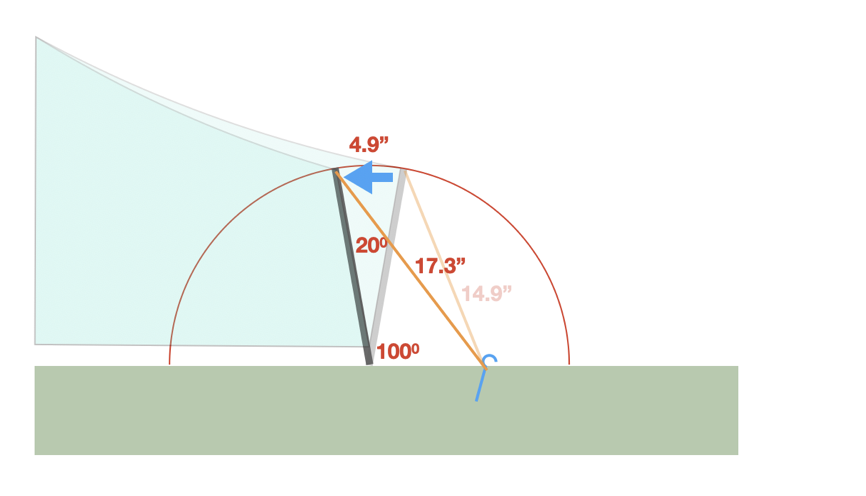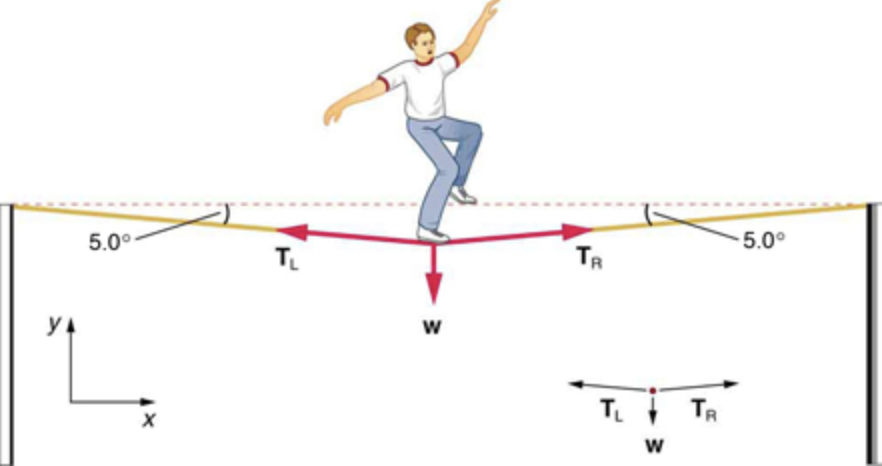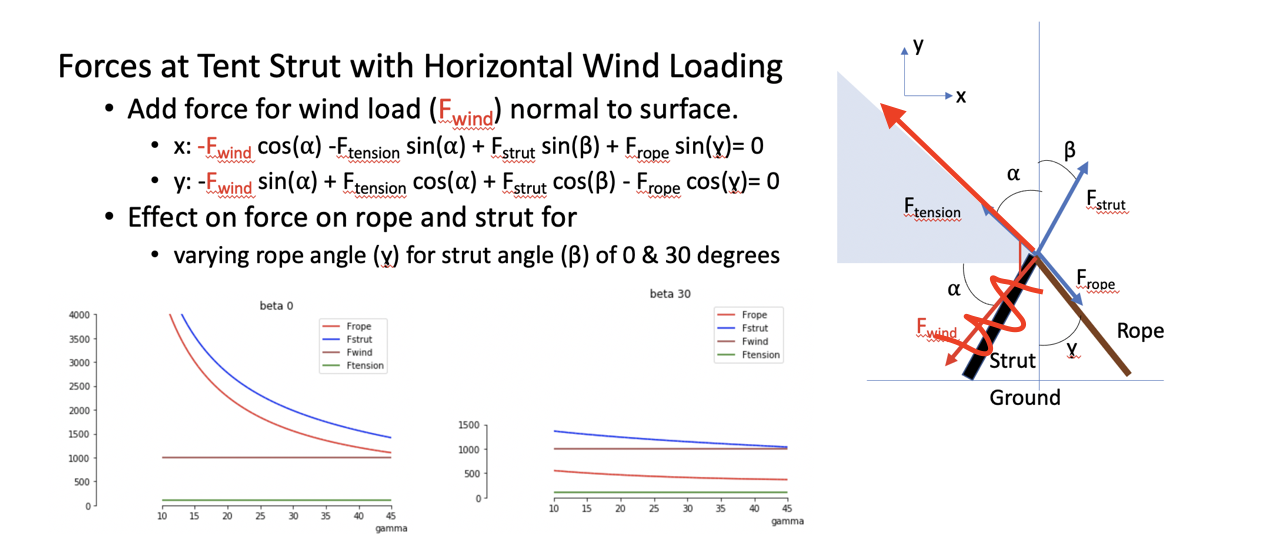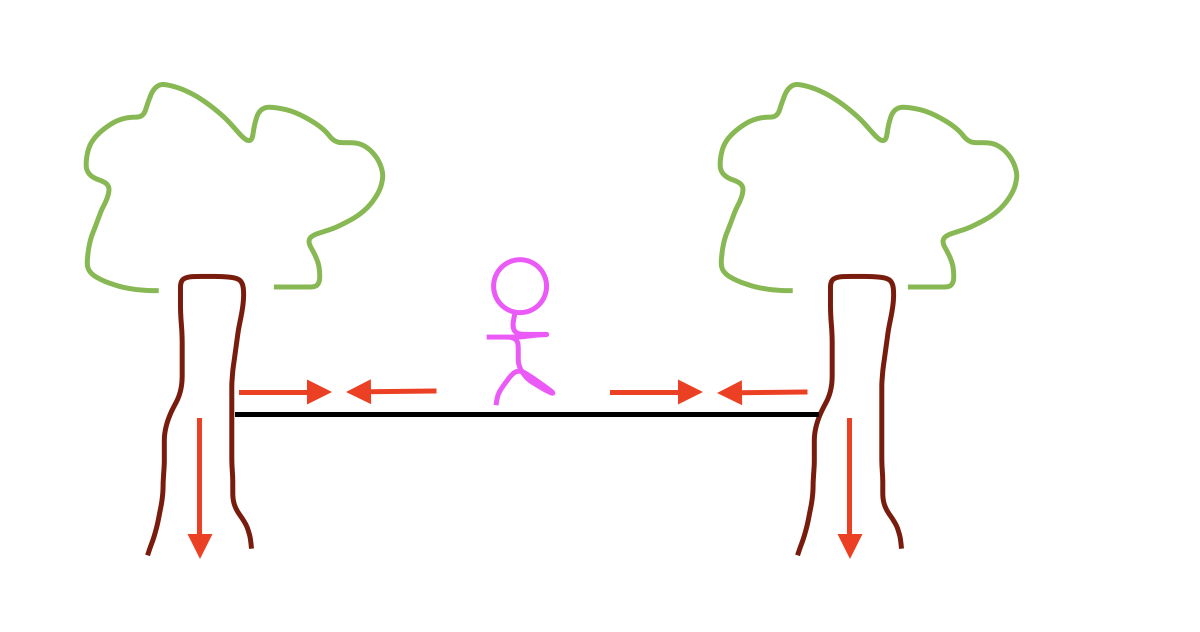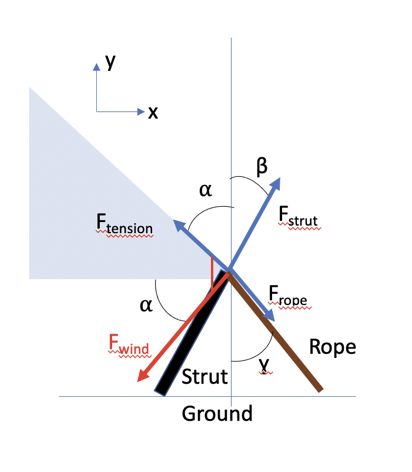Topic
So I have a new Tent plan for 2021…input welcome
Forum Posting
A Membership is required to post in the forums. Login or become a member to post in the member forums!
Home › Forums › Gear Forums › Gear (General) › So I have a new Tent plan for 2021…input welcome
- This topic has 176 replies, 35 voices, and was last updated 3 years, 4 months ago by
 Roger Caffin.
Roger Caffin.
-
AuthorPosts
-
Dec 13, 2020 at 8:49 am #3688693
“I think they just use longer stakes at the pitchlock corners. Known issue with known solution?”
Certainly. Many in the UK and elsewhere in Europe have experienced this as a real world issue and employed the easy solution I mentioned way back on page 1 (longer cord). Some companies such as Hilleberg specifically tell their customers it’s an issue and advise them to use longer cord. As I said originally, it’s not really an issue if people understand it because it can be easily resolved with longer cord or better stakes.“any notion that equations can absolutely prove something which hasn’t been tested in a real world environment is foolhardy.”
There is real world evidence. Switching to longer cords on struts is commonly used in windy environments like the UK to alleviate observed stress issues with a short strut cord. It’s been observed by many people and mentioned in any places . I’ve observed it myself on the PCT where longer cord was the only way to keep the strut stakes in during some very windy nights. It’s substantial enough that companies that make strut corners for 3-4 season conditions (Hilleberg) specifically note to use longer cords.We know high stress from struts + short cords occurs from real world observations. What’s happening here is an attempt to describe mathematically why it occurs. By determining the trigonometry & physics, we can better understand these field observations.
Dec 13, 2020 at 9:41 am #3688701Just for the sake of clarity, we should mention that observations and measurements are two different things, and that possessing knowledge of one without knowledge of the other can be misdirecting.
Dec 13, 2020 at 9:41 am #3688702A lot of “minimalist” shelters require a maximum number of stakes for storm mode.
Dec 13, 2020 at 9:50 am #3688706Rainbow Li fits 2 pads of 25″ width, FWIW.
Dec 13, 2020 at 10:11 am #3688715“observations and measurements are two different things”
A measurement is not so much a different thing but rather a type of observation. There’s a lot we can definitively learn without measuring via other types of observations. For example, if I stand on one chair and it breaks, and then stand on a second chair and it does not break, I have good evidence the second chair is stronger without actually measuring how strong it is. A specific measurement would be nice, but I don’t need that to know the second chair is stronger.That’s what we have right now for struts & stakes. Myself and many others have observed that wind will pull out a stake placed close to the strut, but not further away. That can only occur from (1) greater force on the stake when it’s closer or (2) less holding power (soft soil) at that close position. If it was only one observation the maybe the second possibility is true, but because this experiment has been repeated many times and many people in many places, we can be confident based on real world observations that there really is less force on the stake at greater distances, even without measuring what the exact difference is. Measuring is nice but other forms of observations can also provide clear evidence.
Dec 13, 2020 at 10:13 am #3688717Wow! What a wonderful way to start out a beautiful Sunday morning! Thank you to everyone for contributing to this fascinating thread!
As a residential architect who grew up with dreams of designing “tensioned fabric structures”, I find this conversation incredibly fascinating.
But one thing is getting me hung up: where are all these “levers” and fulcrums that people are speaking about?
I mean, a tent (in it’s ideal form) is all in tension. If we are talking about actual mechanical leverage, wouldn’t the cord that everyone is talking about have to be stiff enough to create actual uplift on the tent stake? Only in this scenario I can understand that a strut becomes an actual fulcrum. But in the way that struts are used in tents, they are clearly designed to stiffen corners and break up fabric spans. To me, they are simply teeny tiny little “trekking poles” that assist the corners of some tents. Henry believes they are worth it, and certainly there a lot of believers out there. And I get that some have had issues with them as well, but the reason “why” they might hinder performance may have more to do with situations where having something “too stiff” might exacerbate the physics of “tugging” on the stake. But this is more in the realm of dynamic loading, not static loading.
I get the math being shown (in essence), but I’m still feeling confused, possibly by being stuck on the usage of engineering terms which I’m not sure are being properly applied.
Any structural or mechanical PE’s out there that can help us all out with this?
(Of course, perhaps I should stick with sticks and bricks for now… :( )
Dec 13, 2020 at 10:34 am #3688725Certainly there has been some casual language for a variety of reasons including attempting to put things into more common terms.
” wouldn’t the cord that everyone is talking about have to be stiff enough to create actual uplift on the tent stake?”
Yes. It is stiff enough because the direction of pull is always fully in the line the fabric and/or cord.To explain the mechanical advantage: Imagine there is a concrete wall a few feet tall near a stake. You tie a cord to the stake, route that cord over the wall, and pull from behind the wall. That wall re-directs your cord and thus the pull to a new angle but doesn’t change the amount of force on the stake (other than some friction losses) because you’re still pulling at a 1:1 ratio (every inch you pull tries to pull the stake by 1 inch) so there is no mechanical advantage.
However, if this wall had a pivot point at the base and your rope was tied to the top of it, with a second rope running from the top of the wall to the stake, then you can get a mechanical advantage on the stake, depending on the angles. If pulling 2 inches on the top of the wall only pulls 1 inch on the stake, then you have a 2:1 mechanical advantage. It’s like a pulley or block and tackle, moreso than a lever.
It’s similar physics as this:

In this example the rope is routed such that when the person pulling on the rope pulls two inches, the load only rises 1 inch, so they can lift a 100 lbs weight with 50 lbs force (2:1 mechanical advantage).
The same can be true at a strut corner. The mechanical linkage of the strut/fulcrum/pivot is different but the outcome can be the same where pulling 2 inches only pulls 1 inch on the stake to create the same 2:1 mechanical advantage.
In my diagrams earlier I showed how a 2:1 mechanical advantage can exist:

“they are simply teeny tiny little “trekking poles” that assist the corners of some tents”
Yes certainly. Similar mechanical advantage can be true with a trekking pole.That’s why this user has their guyline staked out far from the trekking pole and not near the base. If you imagine this user moving the guyline so it’s only a few inches from the base of the pole, I think it’s easy to see why it wouldn’t work so well. There would be huge leverage on the stake so the tent would be floppy (as the cord stretches) and/or the stake would rip out.
 Dec 13, 2020 at 1:18 pm #3688754
Dec 13, 2020 at 1:18 pm #3688754Thanks for that, Dan. That last example gets your point across in a way that makes sense to me.
Dec 13, 2020 at 2:22 pm #3688767My own (biased) opinion is that a lot of this discussion has been going around in circles without any clear idea of the goal.
I’ve observed it myself on the PCT where longer cord was the only way to keep the strut stakes in during some very windy nights.
Just so.So what IS the goal? I suggest it is to keep the tent up, and that this means keeping the peg in the ground.
Now, go out in your backyard and stick a peg in the ground, with string tied to it. Pull the string along the ground and see how much it resists. Fine. Now try pulling upwards at 45 degrees and see how much easier it is to get the peg out. (It’s even worse at 60 degrees.) I could draw engineering diagrams, but I suspect most people can happily visualise this.
So we need to separate the discussion into TWO parts;
1) How to preserve headroom in a tent when the wind is blowing the fabric down flat. Struts work fine for this.
2) How to keep the guy rope from pulling the stake out of the ground. Long guy ropes (meaning low angles) work best for this.Of course, in calm lowland conditions, none of this matters.
Cheers
Dec 13, 2020 at 2:22 pm #3688768With 7,000 miles on a Notch LI I agree that the pitch lock corners rock. With decently sized stakes, the tent has been stable in all sorts of windy conditions and is easy to pitch, usually with only four stakes. It’s great to see an analysis of why it’s worked so well.
Dec 13, 2020 at 4:14 pm #3688790“So we need to separate the discussion into TWO parts;
1) How to preserve headroom in a tent when the wind is blowing the fabric down flat. Struts work fine for this.
We established this way back on page one and no one has expressed any disagreement with the consensus there, so I don’t think we need further discussion on that. Certainly struts are great for that.2) How to keep the guy rope from pulling the stake out of the ground. Long guy ropes (meaning low angles) work best for this.”
Certainly stakes have worse holding power as you pull more vertically but again no one disagrees with this. My argument here is that the advantage of long guylines isn’t simply improving the angle of pull on the stake. A steeper guyline gives a worse angle of pull (unanimously agreed upon) AND a mechanical advantage which multiples pull on the stake (apparently contentious, but obvious from high school physics since it a short line creates a simple 2:1 pulley).
My goal here is demonstrate that this leverage exists, since that has been disputed. I’m not sure why it’s disputed though because we can easily demonstrate that this leverage exists. It’s as simple as showing that 2 inches of movement at the pole tip creates 1″ of movement at the stake (2:1 mechanical advantage) when the guyline is steep (e.g. 30 degrees).My argument is: Here are the measurements showing there is a mechanical advantage with a steep line, therefore there is a mechanical advantage with a steep line.
Dec 13, 2020 at 4:28 pm #3688791Matt,
I am an engineer but of the wrong kind (ECE), and I am waiting to get a bit more help from my mechE kids once they get out of their finals.
The “fulcrum” argument does not make sense to me because, like you remarked, I also expect the tent to mostly not move. Thus I tried to model the static forces using the assumption that the fabric/line do not stretch, i.e. behave like a solid material. For fun (pandemic obliging), I will try to see how the model changes if material stretch is taken into account.
I enjoyed many of the interesting comments, such as ground effect for wind, or the discussion of models vs reality. As a practicing engineer, realistic models can only be simulated, esp. once we take into account the full 3D shape of an actual tent. But back-of-the-envelope physical models can provide some quick insight.
There were arguments made that struts were not helpful from a load’s perspective. I believe the simple model that I derived show that, for example, a 30 degree struts held by a 30 degree guyline reduces forces on the guyline to the stake by 50% compared to not having a strut. It also showed that without wind load, the same 30 degree struts/guyline increased by 10% the force on the guyline compared to not having a strut.
This simple model shows that struts in this configuration would appear to be a good compromise as wind force can significantly exceed the tension needed to just keep the tent taught.
Dec 13, 2020 at 4:51 pm #3688797The issue with your calculations isn’t stretch nor whether or not the tent moves. It’s that you have the force vector in the incorrect direction (I think because you are treating the tent as a rigid body when it’s not).
The example below shows a static load on a slackline where the anchors at either end are not moving, yet the force vectors are in line with the rope, not perpendicular. This the same as what happens with wind hitting a tent panel – it creates forces in line with that panel.

If there was no stretch, the forces along the slack line would not be zero (as you model) but rather infinite. Here is the equation to calculate the force along the line:
Force along the line = (Downward Force x Span)/(Sag * 4)
You can see that explained in this video here:

So you have the force of the wind as perpendicular to the panel when it is actually in line with the panel, like this:

If instead of a slack line we nailed a stiff board between two trees, then the forces along that board would be perpendicular because that board is capable of pushing out to counter the inward force such that the net force at the anchor would be perpendicular to the board (down), like this:

But tent fabric can not push outward like a rigid body (board) can, so we are left with that inward force in line with the fabric, which is why struts increase tension under a wind load. If someone had a steel tent with struts, then your wind modelling would be correct._____________________________
In case all that is unconvincing, I’ll demonstrate this in one more very intuitive way. You have modelled the force vector of the wind as fully perpendicular to the fabric panel, like this:

That puts it almost in line with strut which would be great if it was true because the strut takes nearly all of the force. But consider: If that was true, all we’d need to do is tilt the strut out a little more (to 45 degrees) so it’s fully perpendicular to the panel and the strut would absorb 100% of the wind force, leaving zero force on the stake. Could it be true that extreme winds don’t put any force on the tent stakes if the PitchLoc corners are tilted at 45 degrees? Of course not.
Dec 13, 2020 at 4:56 pm #3688799Yes, I agree with Dan that a steep guyline will have a higher tension in it compared to a long guyline for the same wind. That is basic physics.
My point is that what really matters is whether the tent peg can handle that tension. If the tent peg was actually an eyebolt in sheet granite, the tension in the guyline would not matter (as long as the eyebolt held!), while if the tent peg was a Ti wire poked casually into soft snow or light duff, even a low angle of guyline would probably pull it out.
Whoever thought there was so much physics/engineering in pitching a tent? :)
Cheers
Dec 13, 2020 at 4:57 pm #3688800“I agree with Dan that a steep guyline will have a higher tension in it compared to a long guyline for the same wind. That is basic physics.”
Thank youDec 13, 2020 at 4:59 pm #3688801So don’t play with a slackline over an alligator pit!
Dec 13, 2020 at 5:04 pm #3688803Whoever thought there was so much physics/engineering in pitching a tent? :)
I kind of thought that eventuality was usually due to something physical…
Dec 13, 2020 at 6:10 pm #3688809Wow. Wacky-cool off-the-charts discussion.
I’ve had a bunch of these tents and tarps. TT’s, MLD’s, mids, etc. Loved most of them for one reason or another. [MLD Cricket is a mini TrailStar – superior in the wind! Aeon is stiff as a million-dollar kite.] Sold a bunch that had the wrong down-sides for me (E.g, “How many bloody minimum stake-out points?!?”, “Wow, I can stash, maybe a stinking >peanut< in that zero-headroom, wasted space!!”)
To start with, the bottom line is to both KYG* and BEG** (so to speak).
FWIW, I scanned and ran a bit ahead of the posts just to get this ^^^ in, but also noted three key points I got from several parts of the pitchloc discussion (YMMV):
1. Remember Henry’s note about the fulcrum (that’s why the steeper angle of that triangular plane in the pitchloc pyramid is better);
2. One of several(!) important conclusions Alexander E made from his calculations (IIRC) is that the wind force pushes the struts (bottom line in the pitchloc pyramid’s inner triangular plane) downward – this simple variable throws the circularity of the arch in Dan’s earlier sample into a variable parabola;
3. Roger’s very practical chart about wind speed and elevation – one could just have a simple fixed horizontal force variable for the wind, but per the Roger’s chart the force on the outer pitchloc triangle is less than the force on the seam line and or tent panel polygon(s) – and that doesn’t even count whether there is aerodynamic deflection from the panel polygons’ catenaries.
Very Complex.
Additionally, on the recently posts on rigid vs non-rigid:
1. We’re dealing with differently rated materials across several different sorts of polygonal solids – the pitchloc pyramid with cf tubes and braided lines and the tent body of DCF or SylNy panels. If the design is correct to the shapes and materials, they all “can” be rigid with the stake sent home like any good BPL master. If there is a failure of the stakes planting, that failure will result in a variable level of loss of rigidity depending on the design and the material.
2. The rigidity is both a KYG issue (a crappy pitch is a crappy pitch) and an issue of what level of theoretical rigidity any particular design has to start with [Goodyear (great) vs. Nobile’s Norge (superior) vs. Zeppelin (19th C. cheating)] – in other words, crappy catenaries are crappy catenaries.
Quite Variable.
Not trained as an engineer, but I read a lot and work with structural engineers a lot. In the case of proving all of this in a comparative fashion – good luck…I did take a lot of graduate school statistics and the multiple regression analyses needed for this would be in the territory of “Yikes!”
I like Dan and I like Henry and I like Ron. They all make killer kit. Buy their stuff. Do training/shake-down hikes. Get on the Trail.
My Dos Centavos
Vance
* – Know Your Gear (that always includes having the location-awareness of your shelter pitch – trees, soil, wind direction, etc.)
** – Bring Enough Gun (trying to say that if you bring the wrong gear, bad on you, not the gear)
Dec 13, 2020 at 6:10 pm #3688810So…again, a heavy rock or pile of smaller rocks on stakes will solve all this? Is there any reason to object to struts if you can effectively create the equivalent of “an eyebolt in sheet granite”?
where I hike there are more rocks around than you can shake a stake at.
Dec 13, 2020 at 6:18 pm #3688811“Alexander E made from his calculations (IIRC) is that the wind force pushes the struts (bottom line in the pitchloc pyramid’s inner triangular plane) downward – this simple variable throws the circularity of the arch in Dan’s earlier sample into a variable parabola;”
I wouldn’t put this as a key point because it’s incorrect. And Alexender didn’t calculate that. He attempted to research the force direction and then did calculations based on that (incorrect) research.The wind force at the strut is not downward (perpendicular to the panel). See my post a few posts up from here for an in depth explanation of that complete with diagrams, equations and videos.
If that was true (the wind force is perpendicular to the panel) then it would also be true at a stake corner. Consider, when the wind hits the panel, does it only push downward on the stake like this?

If so, there would be zero force trying to rip the stake out. The wind would only be pushing the stake in, which is obviously wrong. Wind does rip stakes out.Alexander has the force diagram for the strut corner incorrect by concluding the direction is perpendicular to the panel, and he has the force diagram for the non-strut corner double-incorrect by concluding the direction is perpendicular AND that this force is applied at a distance back from the stake. If he was correct about it being perpendicular, then it would be perpendicular at the ends like I have sketched above.
The correct force diagram is like this:

Wind hits the panel and causes upward pull in line with the panel. The net force is downward, but that’s from an upward pull on the stake combined with a downward pull on the peak. So wind does try to rip out the stake, and in the case of a strut corner, does attempt to rotate it around the arch I showed earlier which results in that mechanical advantage.Dec 13, 2020 at 6:19 pm #3688812If all you have is rocks, then that is what you work with. Preferably big rocks. I have shown photos of that.
I have no objection to struts. In fact, I have considerable support (sorry about the pun) for them in windy conditions. They will keep the fly off you. I have also shown photos of that.
Academically, yes of course the tent will push the strut downwards. If it didn’t, then the tent would go airborne. But so what? A CF tube will be plenty strong enough! Ah – that might not work in snow, as the CF tube would go straight in. Sand is also iffy. Check the ground there.
Cheers
Dec 13, 2020 at 7:05 pm #3688819Dan,
Your point is well taken on the rope analogy. This analogy is also a simplified model: the weight apply forces at a single point in the middle of the rope; a fabric in the wind experience forces for every square inch of its surface. So neither solid vs weight in the middle modes are precise. As a sailor, the wind hitting a sail makes the boat going forward with a force perpendicular to sail; so clearly not all of the forces is dissipated in the fabric. This analogy is also fraught as the boat can move, hopefully not the tent :-)
Surprisingly, there is not much out there on the forces on tents, so I am not getting much success so far from academical papers. The only way to get better data might be a finite-element mesh modeling. Maybe an interesting problem for a grad student.
Dec 13, 2020 at 7:20 pm #3688824Sorry Dan – The imprecision of your assumptions keep accumulating based on the simplistic isolation of variables. Of course the wind isn’t pressing perfectly perpendicular to the panel, but it also isn’t exerting equal pressure at every point on the panel as in your diagram. And I don’t think “double-incorrect” is quantifiable…
Roger – I also use Rocks.
Vance
Dec 13, 2020 at 7:22 pm #3688825The forces on a sail boat are like this:

Wind hits the sail at all points (pink arrows). Those forces are translated into forces in line with the sail acting at both ends of the sail (green arrows). The sail will deflect until the sum of those green arrows equals the sum of the pink arrows.So we have a force on the bottom of the sail that is up and forward, and a force on the top of the sail that is down and forward. Both are in line with the sail. A limp material like a sail or rope can not pull in any direction other than in line with it. For the entire boat, the up and down portions of these green arrows cancel out, to give a force on the boat (orange arrow) that is perpendicular to the wind. We are interested in forces at the stake (e.g. green arrow) not the whole boat (orange arrow).
“As a sailor, the wind hitting a sail makes the boat going forward with a force perpendicular to sail; so clearly not all of the forces is dissipated in the fabric.”
Yes that is our orange arrow.
“The imprecision of your assumptions keep accumulating based on the simplistic isolation of variables. Of course the wind isn’t pressing perfectly perpendicular to the panel, but it also isn’t exerting equal pressure at every point on the panel as in your diagram”
Certainly the wind isn’t exerting equal pressure everywhere but that’s irrelevant to the amount and direction of force on the stake. Notice that physics equation for the force on the stake only includes the sum of the wind:Force at stake = (Sum of the wind force / length panel) / (deflection * 4).
This isn’t an imprecise assumption – it’s the complete force equation. This is also why it doesn’t matter if we have wind hitting all over the sail, or a force at a specific spot.
“This analogy is also a simplified model: the weight apply forces at a single point in the middle of the rope; a fabric in the wind experience forces for every square inch of its surface.”
Yes but as explained above, it doesn’t matter. Only the sum matters, so 100 kN of force from a person on a rope gives the same forces on the anchor as 100 kN of wind hitting a sail.Dec 13, 2020 at 7:55 pm #3688834the wind hitting a sail makes the boat going forward with a force perpendicular to sail
I have seen yachts sailing (tacking) INTO the wind. I suspect the model presented here is not entirely correct. Not that it matters.Cheers
-
AuthorPosts
- You must be logged in to reply to this topic.
Forum Posting
A Membership is required to post in the forums. Login or become a member to post in the member forums!
Our Community Posts are Moderated
Backpacking Light community posts are moderated and here to foster helpful and positive discussions about lightweight backpacking. Please be mindful of our values and boundaries and review our Community Guidelines prior to posting.
Get the Newsletter
Gear Research & Discovery Tools
- Browse our curated Gear Shop
- See the latest Gear Deals and Sales
- Our Recommendations
- Search for Gear on Sale with the Gear Finder
- Used Gear Swap
- Member Gear Reviews and BPL Gear Review Articles
- Browse by Gear Type or Brand.


